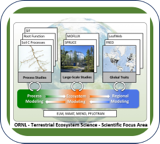Guidelines and considerations for designing field experiments simulating precipitation extremes in forest ecosystems
| Author |
|
|---|---|
| Keywords | |
| Abstract |
Abstract Precipitation regimes are changing in response to climate change, yet understanding of how forest ecosystems respond to extreme droughts and pluvials remains incomplete. As future precipitation extremes will likely fall outside the range of historical variability, precipitation manipulation experiments (PMEs) are critical to advancing knowledge about potential ecosystem responses. However, few PMEs have been conducted in forests compared to short-statured ecosystems, and forest PMEs have unique design requirements and constraints. Moreover, past forest PMEs have lacked coordination, limiting cross-site comparisons. Here, we review and synthesize approaches, challenges, and opportunities for conducting PMEs in forests, with the goal of guiding design decisions, while maximizing the potential for coordination. We reviewed 63 forest PMEs at 70 sites world-wide. Workshops, meetings, and communications with experimentalists were used to generate and build consensus around approaches for addressing the key challenges and enhancing coordination. Past forest PMEs employed a variety of study designs related to treatment level, replication, plot and infrastructure characteristics, and measurement approaches. Important considerations for establishing new forest PMEs include: selecting appropriate treatment levels to reach ecological thresholds; balancing cost, logistical complexity, and effectiveness in infrastructure design; and preventing unintended water subsidies. Response variables in forest PMEs were organized into three broad tiers reflecting increasing complexity and resource intensiveness, with the first tier representing a recommended core set of common measurements. Differences in site conditions combined with unique research questions of experimentalists necessitate careful adaptation of guidelines for forest PMEs to balance local objectives with coordination among experiments. We advocate adoption of a common framework for coordinating forest PME design to enhance cross-site comparability and advance fundamental knowledge about the response and sensitivity of diverse forest ecosystems to precipitation extremes.
|
| Year of Publication |
2018
|
| Journal |
Methods in Ecology and Evolution
|
| Volume |
online
|
| Start Page |
1
|
| Date Published |
09/16/2018
|
| URL |
https://besjournals.onlinelibrary.wiley.com/doi/abs/10.1111/2041-210X.13094
|
| DOI |
10.1111/2041-210X.13094
|
| Download citation |

